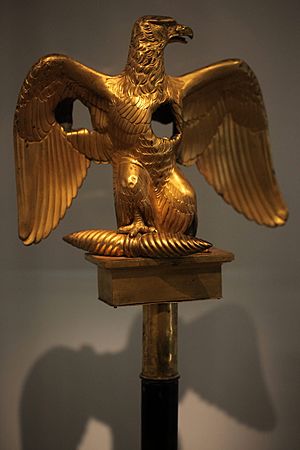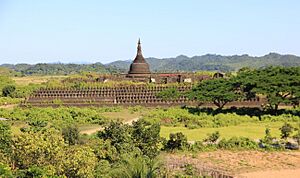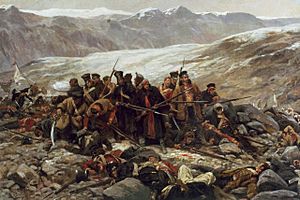44th (East Essex) Regiment of Foot facts for kids
Quick facts for kids 44th Regiment of Foot |
|
|---|---|

Colours of the 44th Regiment of Foot
|
|
| Active | 1741–1881 |
| Country | |
| Branch | |
| Role | Infantry |
| Size | One battalion (two battalions 1803–1816) |
| Garrison/HQ | Warley Barracks, Brentwood |
| Nickname(s) | The Fighting Fours |
| Colours | Old colours of the 44th are laid up at Essex Regiment Chapel. |
| Engagements | Jacobite rising French and Indian War American Revolutionary War French Revolutionary Wars Napoleonic Wars First Anglo-Burmese War First Anglo-Afghan War Crimean War Second Opium War |
| Commanders | |
| Notable commanders |
James Long Charles Staveley |
The 44th Regiment of Foot was a famous infantry (foot soldier) regiment in the British Army. It was started in 1741. Later, in 1881, it joined with another regiment, the 56th (West Essex) Regiment of Foot, to form the Essex Regiment.
Contents
History of the Fighting Fours
Early Adventures (1741-1786)
The regiment began in 1741, created by Colonel James Long. It was first called 'James Long's Regiment of Foot'. They fought in the Jacobite rising in Scotland in 1745. In 1751, it was officially named the 44th Regiment of Foot.
In 1755, the regiment sailed to North America to fight in the French and Indian War. They were part of the Battle of the Monongahela, where their leader, Colonel Sir Peter Halkett, was killed. They also fought in battles like Battle of Carillon (1758) and Battle of Fort Niagara (1759). They helped capture Montreal in 1760 before returning home in 1765.
The regiment went back to North America in 1775 for the American Revolutionary War. They fought in important battles such as the Battle of Brooklyn (1776), Battle of Brandywine (1777), and Battle of Germantown (1777). In 1782, the regiment was given a county name and became the 44th (the East Essex) Regiment of Foot.
Fighting in the Napoleonic Wars (1795-1815)
In 1795, the regiment was sent to the West Indies to fight in the French Revolutionary Wars. They helped take back islands like Martinique and Saint Lucia. After that, they went to Egypt in 1800. They fought in the Battle of Alexandria and helped capture Cairo in 1801.
The regiment grew to have two battalions (groups of soldiers) in 1803. The 1st battalion went to North America in 1814 for the War of 1812. They fought in the Battle of Bladensburg and the famous Battle of New Orleans.
Meanwhile, the 2nd battalion was fighting in Europe. They arrived in Portugal in 1810 and took part in many battles, including the Battle of Sabugal (1811) and the Battle of Fuentes de Oñoro (1811). At the Battle of Salamanca in 1812, a brave soldier named Lieutenant William Pearce captured a special French flag called a French Imperial Eagle. This was a great honor! The 2nd battalion also fought in the very famous Battle of Waterloo in June 1815.
Adventures in Asia (1825-1861)
In 1822, the regiment went to India. In 1825, they were sent to Burma for the First Anglo-Burmese War. They marched up the Irrawaddy River and, led by Lieutenant Colonel John Shelton, captured the city of Arakan. Many soldiers got sick from fever, so the regiment returned to India in 1826.
The regiment faced a very tough time during the First Anglo-Afghan War. In 1840, they were stationed in Kabul, Afghanistan. In January 1842, they had to retreat in deep snow. This was a very difficult journey, and many soldiers were lost. Only one British officer, Surgeon William Brydon, managed to reach safety. A small group of about 65 soldiers, including Captain Thomas Souter, were surrounded. They bravely refused to give up and fought until the end. Captain Souter survived because he had wrapped the regimental flags around his waist, making the attackers think he was a high-ranking officer.
The Crimean War (1854-1855)
The 44th Regiment was rebuilt and sent to Varna in 1854 for the Crimean War. They fought in major battles like the Battle of the Alma (1854) and the Battle of Inkerman (1854). They also took part in the long siege of Sevastopol.
The Second Opium War (1860)
In 1860, the regiment sailed to China for the Second Opium War. They were part of a force that captured the Taku Forts on August 21, 1860. The 44th Regiment led the attack on the North Taku forts. They bravely crossed ditches and climbed walls under heavy fire. Lieutenant Robert Montresor Rogers was the first British officer to enter the fort and won the Victoria Cross for his bravery. Private John McDougall also won the Victoria Cross for his courage. The regiment left China in 1861 and went back to India.
Joining Forces: The Essex Regiment (1881)
In 1881, the 44th Regiment of Foot joined with the 56th (West Essex) Regiment of Foot to create a new, larger regiment called the Essex Regiment. This was part of a big change in the British Army.
Later, the Essex Regiment also joined with other regiments. In 1957, it merged to form the 3rd East Anglian Regiment. Then, in 1966, several regiments combined to create the Royal Anglian Regiment. Today, the legacy of the 44th Regiment of Foot lives on as the 3rd Battalion of the Royal Anglian Regiment.
In Fiction
The story of a fictional regiment capturing a French Imperial Eagle in Bernard Cornwell's book Sharpe's Eagle is based on the real event where the 44th Regiment captured an Eagle at the Battle of Salamanca.
Battle Honors
The 44th Regiment earned many honors for their bravery in battles. These include:
- Egypt
- Badajoz, Salamanca, Peninsula (from the Peninsular War)
- Bladensburg (from the War of 1812)
- Waterloo (from the Napoleonic Wars)
- Ava (from the Anglo-Burmese War)
- Alma, Inkerman, Sevastopol (from the Crimean War)
- Taku Forts (from the Second Opium War)
Victoria Cross Awards
Some very brave soldiers from the regiment were awarded the Victoria Cross, the highest award for bravery in the British military:
- Private John McDougall (for bravery in the Second Opium War, 1860)
- Sergeant William McWheeney (for bravery in the Crimean War, 1854)
- Lieutenant Robert Montresor Rogers (for bravery in the Second Opium War, 1860)
Images for kids












